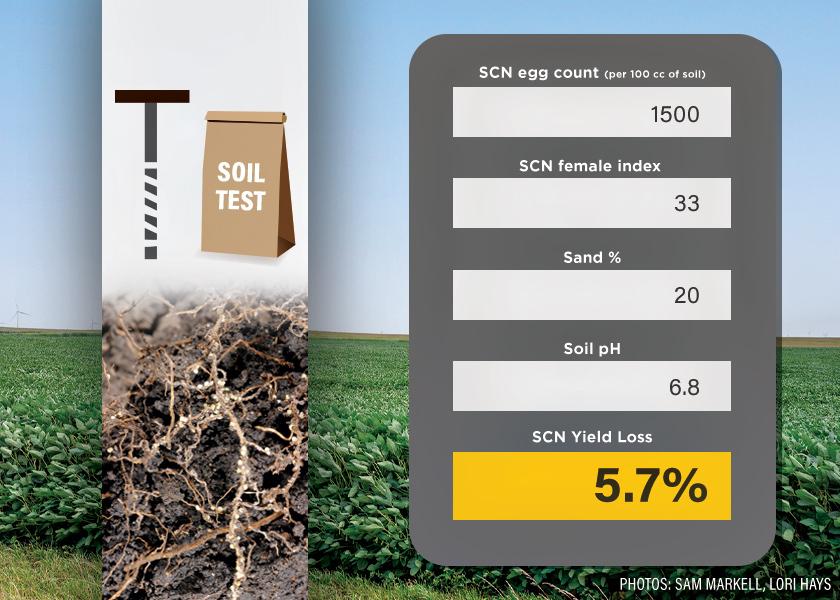New Profit Calculator Reveals How Much Soybean Cyst Nematode Costs You By Field

Soybean cyst nematode (SCN) is the most costly pest in U.S. soybeans today, routinely reducing yields in affected fields by 5 bushels or more per acre, according to the Crop Protection Network.
Now, thanks to a new, online tool called the SCN Profit Checker calculator, growers can calculate how much the pest is costing them in dollars and cents on a field-by-field basis.
“It’s very easy to use, and we’ll utilize it more this fall as we pull soil samples and do SCN counts,” says Summer Ory, who has evaluated the tool along with her husband, Dan, on their corn-soybean and livestock farm near Earlham, Iowa.
“We know SCN is out there wreaking havoc, and this gives us a new metric to find out how much damage it’s causing,” she adds.
Today, SCN is wide-ranging across the United States. Only West Virginia has not found any SCN in its commercial soybean fields.
Based On Test Plot Data
The free, online tool was developed thanks to more than 25,000 university research plots, according to Greg Tylka, Iowa State University nematologist and Morrill professor in the Department of Plant Pathology and Microbiology.
“We have the data from small research plots from across Iowa and (other states), which was mostly funded by the Soybean Checkoff, and we’ve used that information to develop the calculator,” Tylka said during a recent discussion on AgriTalk.
Tylka says the researchers who developed the calculator determined that there are four factors that have a primary effect on SCN reproduction and the level of yield loss commonly associated with it. The four key factors are egg counts, the SCN female index, a field’s sand content percentage, and the field’s soil pH.
Most farmers are familiar with three of those four factors, with the SCN female index being the one likely exception.
What Is An SCN Female Index?
The female index represents the level of SCN reproduction the pest has in fields planted to PI 88788-based soybean varieties. The PI 88788 breeding line has been included in more than 95% of all SCN-resistant soybean varieties for more than 20 years. Unfortunately, SCN is increasingly able to overcome that breeding line.
“When SCN-resistant soybean varieties first became available for use in the field, they allowed less than 10% SCN reproduction, or they provided more than 90% control,” the SCN Coalition reports. “Today, research shows that in some fields planted with varieties containing PI 88788 genetics, SCN reproduction levels are reaching 75% to 90%, which is just 10% to 25% control.” Learn more at www.thescncoalition.com/.
Tylka says to make the calculator usable for everyone, the Coalition asked soybean experts in each state to provide a default value to start with of the female index representing their state. “So, if a farmer doesn't have a female index, then he or she can pick the default value and still use the calculator,” Tylka explains.
Your Yield Results And Price Are Needed
Last but not least, to use the calculator, a soybean farmer will need to plug in his yield goal or yield results for a field and the market price he expects to get when he sells the crop.
“The calculator takes that information and converts it into dollars and cents for the yield loss per acre they can expect in that field from SCN,” Tylka says.
Ory and her family use rotation and a nematode-protectant seed treatment to battle SCN. While they appreciate having access to the calculator to estimate losses to the pest, what they really want are solutions.
“SCN is increasingly resistant to the existing genetics. What soybean growers really need is new technology to help us combat it,” she says.
Tylka says the SCN Profit Checker calculator can be accessed by computer, smartphone or iPad at www.thescncoalition.com/profitchecker/
As a reminder, he encourages farmers to pull soil samples this fall and check their SCN numbers. His recent discussion on AgriTalk is available to listen to on demand here:







